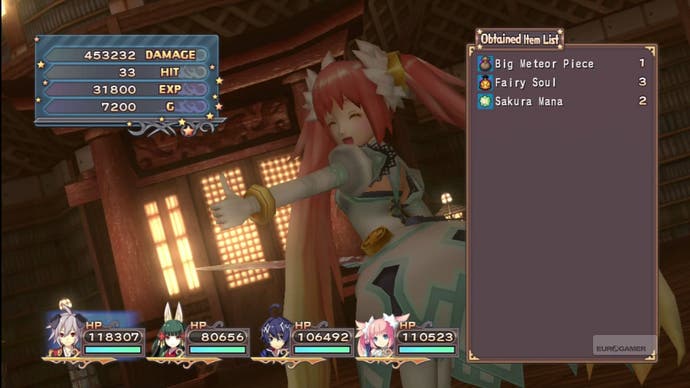Trinity Universe
Dood, where's my star?
It's a shame, as once you grow accustomed to the battle system's foibles, combat becomes much more fun, and there's a good degree of flexibility. Though too many enemies are easily dispatched with the most basic attacks, and the early bosses feel like wars of attrition - most will simply alternate between attacking with a pair of characters and healing with the other two - larger battles eventually see the hit counter ticking over well into the hundreds. Pulling off a well-timed combo attack to finish off a particularly gruelling encounter is satisfying for the knowledge that you've not simply picked an option from a menu: timing is all-important.
On top of the usual ability buffs and stat-boosting accoutrements, Managraphics are something a little different. A couple of hours in, you'll meet a timid artist named Miyu who can paint your weapon with mana you've obtained from dungeons. As well as making weapons look more interesting, these add elemental damage and battlefield effects to your attacks.
The unstable nature of the dungeons means that they offer up fresh items should you revisit them at a different time of day, and they can also start to drift into deep space while you're exploring them, forcing a rush towards the exit as a timer ticks down. It's often worth hanging around until the final seconds, as valuable objects often materialise in rooms and corridors you've previously visited.

Fail to reach the start in time and it's not game over, though you'll need to pay a fee to any passing space travellers to get back to Empyria. Unfortunately, it's usually during these drifts that you'll happen across the Lurkers, and it's infuriating to lose your team - and half an hour of hard work - so close to home. It'd be an interesting risk/reward idea if it wasn't for the fact that Lurkers so often seem to block your one route to the exit.
The 2D art is very pretty, with otherwise static cut-scenes brought to life with so-called Active Animation. By comparison, dungeons are pretty ugly: character models and backdrops are little more than hi-def PS2 visuals and monster design is similarly uninspiring. The music is fairly forgettable, with one catchy piece of J-Pop repeating just a little too often for comfort, amongst a host of nondescript dungeon themes.
Though the quality of the acting is generally decent, the English language track is only a partial dub, so much of the text appears in silence. That said, you'll welcome the respite from the irritatingly shrill pitch of much of the spoken dialogue. By the five-hour mark I was so fed up of Prinny's whining and "dood" after every single utterance that I'd switched to the Japanese voice track, and that's hardly an improvement.

It's tempting to simply skip through the dialogue - and it's admirable that there's an option to do so - but for the fact that you'll miss some genuinely amusing exchanges. Nippon Ichi scripts have always had their share of fourth-wall-breaking moments, but there's plenty of bawdy humour too, with an early exchange seeing Etna erupt at comments about her flat chest, and the unfortunately-named Recit being mercilessly mocked for "sounding like something you'd throw in the trash".
It's the script that carries you through the tedious one-button bludgeonings you'll deal out to weaker foes and the spikes of frustration with Lurkers and bosses. It will allow some to look past the sluggishness of the attack commands and the brief but irritating loading pauses for each battle.
But Nippon Ichi fanatics already have the deeper, more tactical Cross Edge, while newcomers have plenty more accessible - and vastly better-looking - role-players on PS3 to keep them busy. While it's commendable that publishers are still localising these quintessentially weird and wonderful Japanese games, ironically, Trinity Universe's biggest problem might just be that it's not quite crazy enough.
